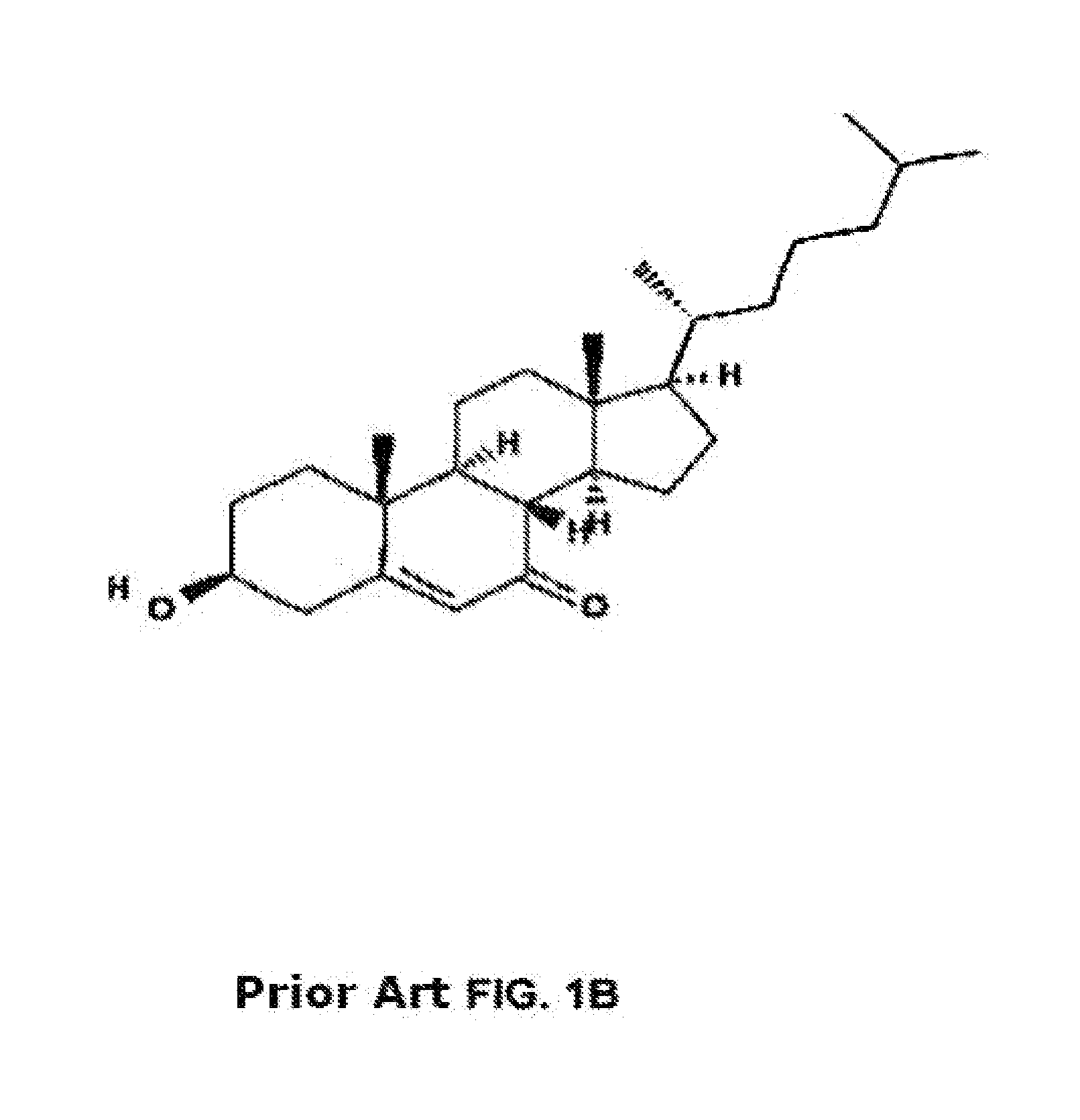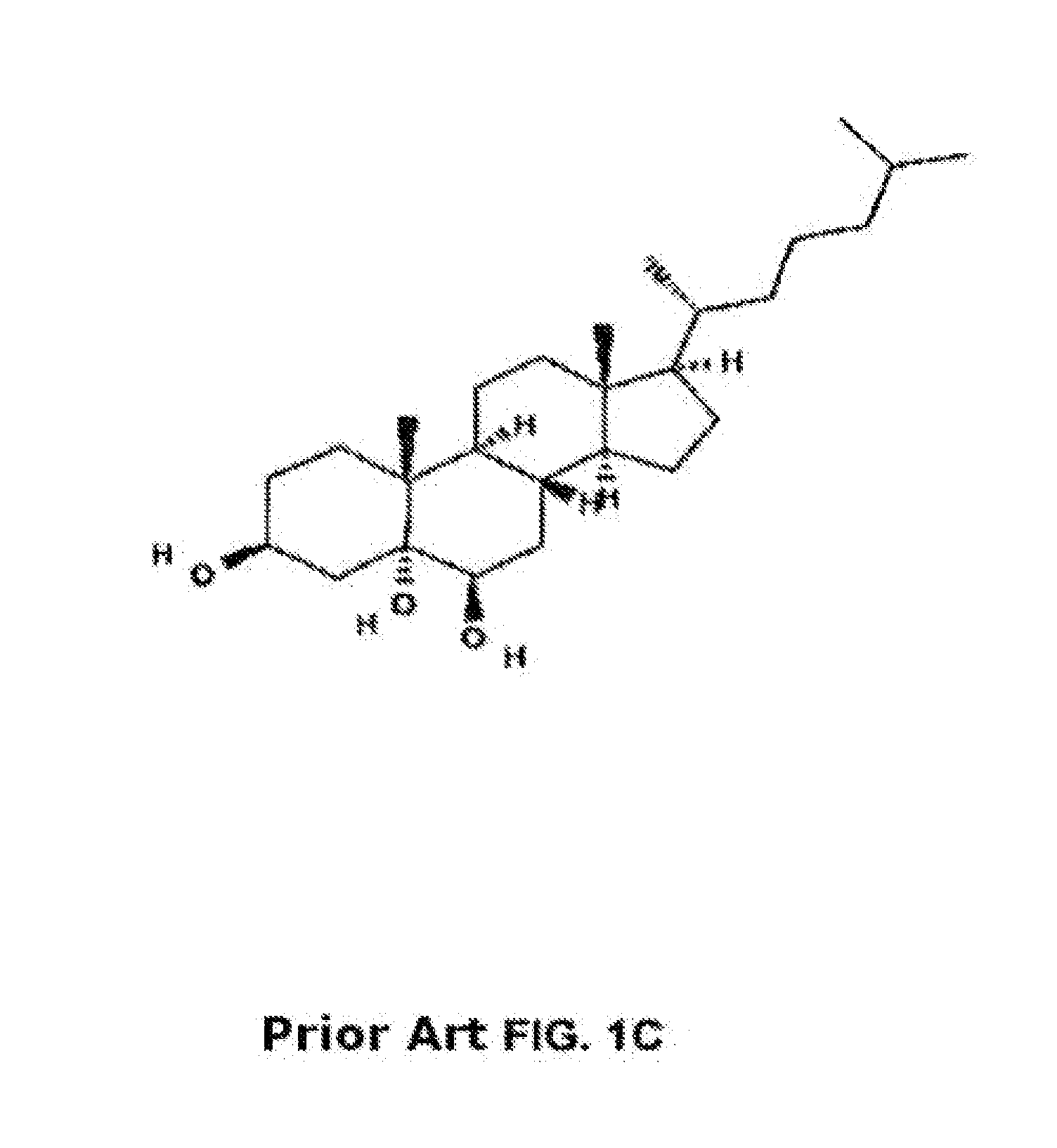Methods of determining efficacy of cyclodextrin therapy
a cyclodextrin and efficacy technology, applied in the field of biomarkers for disorders, can solve the problems of delayed down-regulation of the receptor and de novo cholesterol biosynthesis, lysosomal sequestration of ldl cholesterol, and impaired atp-binding cassette transporter (abca1)-mediated cholesterol efflux
- Summary
- Abstract
- Description
- Claims
- Application Information
AI Technical Summary
Benefits of technology
Problems solved by technology
Method used
Image
Examples
example 1
Isolation of Oxysterols from NPC Patient Samples
[0097]200 pmol of d5-27-hydroxycholesterol (27-HC), 50 μg butylated hydroxytoluene (BHT) and a magnetic flea bar are added to a 10 mL centrifuge tube. The tube is placed under a gentle stream of argon. 250 μL of plasma from a subject and 2.5 mL 0.35 M KOH is added to the tube. The tube is sealed tightly with a Teflon-lined screw cap, vortexed, and allowed to incubate for 2 hr at room temperature while stirring. After incubation, the flea bar is removed and the tube is centrifuged at 3000 rpm for 5 min to pellet the protein. The liquid phase of plasma mixture is removed and added to a 10 mL centrifuge tube placed under argon stream. The tube is then sealed tightly. The pH of liquid phase is lowered to approximately 7.0-8.0 using a 110 dilution of 85% H3P04. While vortexing the centrifuge tube, 200 μL of H3P04 is added dropwise to the plasma mixture until desired pH is achieved. 1.54 mL of 150 in M. NaCl and 4.5 mL CHCl3 is added to the ...
example 2
Oxysterol Purification Using Aminopropyl and Silica Columns
[0098]The extracted lipid samples are resuspended in 250-300 μL CHCl3 and then vortexed. One or more aminopropyl columns (Sep-Pak Vac RC 500 mg NH2 Cartridges, part no. WAT054515) are primed with 4 mL hexane and are loaded with the lipid sample in CHCl3. The sample drips into the column using gravity. The neutral fraction is eluted with 4 mL CHCl3 / isopropyl (2:1 v / v) and then dried under argon. The neutral fraction is resuspended in 1 mL toluene and the fraction is added to a silica column (Isolute 100 mg SI 10 mL XL cartridges, part no. 460-0010-G) primed with 4 mL hexane. The neutral fraction volume is pulled through the silica column (without drying out Wing vacuum. The column is washed with 8 mL of 0.5% isopropyl in hexane, followed by elution of the neutral fraction with 2 mL of 30% isopropyl in hexane. The eluted fraction is collected and dried under argon. After silica column purification, the sample is resuspended in...
example 3
Derivatization of Oxysterols from Plasma Samples
[0099]To derivatize the oxysterols, a solution of 5:2:1 (v:v:v) of Pyridine: Hexamethyldisilazane:Trimethylchlorosilane is mixed in a centrifuge tube, vortexed, and the solution is centrifuged at 3400 rpm for 2 min. 100 μL of the derivatization solution is added to each of the samples prepared above containing the oxysterol component in eppendorf tubes. The eppendorf tubes are then sealed tightly, vortexed, and the derivatization solution and samples are incubated at 60° C. for 30 min. The reaction product containing the derivatized oxysterols is then dried down under a stream of argon. The derivatized oxysterols are resuspended in 100 μL heptane and the resuspension is then vortexed, centrifuged and transferred to an autosampler vial.
PUM
| Property | Measurement | Unit |
|---|---|---|
| temperature | aaaaa | aaaaa |
| temperature | aaaaa | aaaaa |
| time | aaaaa | aaaaa |
Abstract
Description
Claims
Application Information
 Login to View More
Login to View More - R&D
- Intellectual Property
- Life Sciences
- Materials
- Tech Scout
- Unparalleled Data Quality
- Higher Quality Content
- 60% Fewer Hallucinations
Browse by: Latest US Patents, China's latest patents, Technical Efficacy Thesaurus, Application Domain, Technology Topic, Popular Technical Reports.
© 2025 PatSnap. All rights reserved.Legal|Privacy policy|Modern Slavery Act Transparency Statement|Sitemap|About US| Contact US: help@patsnap.com



